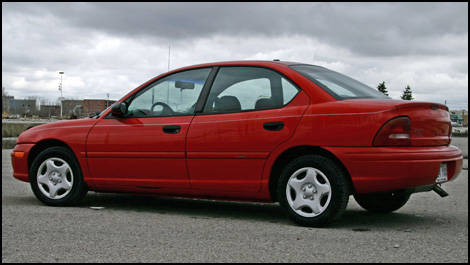Safety
The Neon had standard dual front air bags and available ABS brake. The NHTSA (National Highway Traffic Safety Administration) awarded the 1995 car 3 out of 5 stars (an average result) for both frontal occupants. In 1996, the rating climbed to 4 out of 5 stars (a good result) for both frontal occupants. For 1998and 1999, the driver side frontal rating was decreased to 3 out of 5 stars. The IIHS (Insurance Institute for Highway Safety) rated the Neon "Poor" in its category.
Conclusion
Even though the Neon brought home a slew of awards in 1995, it was not long before the problems started; water infiltration, poor build quality, engine failures, etc. The car fell from very high and it took the better part of the following three years to review all of these concerns. All of this blemished the name Neon and I suspect that this is why the name changed in 2003.
If you are thinking about purchasing a used Neon, I would strongly recommend that you consider a model built after 2000 because of the adjustments brought to the car. If at all possible, I would even maintain that the best ones to buy are the 2003-04 as they were sold with a 7 year/115,000 km powertrain warranty.
Good stuff:
Styling
Interior room
Not so good stuff:
Reliability
Noisy
Problem areas:
4-cylinder head gaskets
Brakes (especially in the rear)
Suspension (especially in the rear)
Electrical connectors and connections
Competitors of the day:
Mazda Protegé
Honda Civic
Nissan Sentra
Subaru Impreza
Ford Escort
Chevrolet Cavalier / Pontiac Sunfire
Toyota Corolla
Recalls:
TC # 1997171
The steering column coupler may become disconnected when the vehicle experiences a severe impact to the undercarriage. This would result in loss of steering control.
TC # 1996186
The fuel and rear brake tubes may experience accelerated corrosion between the tubes and a rubber isolator. Failure of these tubes could result in fuel leakage and/or diminished braking capacity.
TC # 1997102
The circuit design in the air bag electronic control module may allow the potential for inadvertent air bag deployment upon vehicle ignition shut down.
TC # 1996079
On certain vehicles, the brake master cylinder may leak brake fluid due to a damaged double lip rear piston seal. Brake fluid leakage may result in diminished effectiveness of one portion of the split brake system.
photo:Matt St-Pierre
The Neon had standard dual front air bags and available ABS brake. The NHTSA (National Highway Traffic Safety Administration) awarded the 1995 car 3 out of 5 stars (an average result) for both frontal occupants. In 1996, the rating climbed to 4 out of 5 stars (a good result) for both frontal occupants. For 1998and 1999, the driver side frontal rating was decreased to 3 out of 5 stars. The IIHS (Insurance Institute for Highway Safety) rated the Neon "Poor" in its category.
 |
Conclusion
Even though the Neon brought home a slew of awards in 1995, it was not long before the problems started; water infiltration, poor build quality, engine failures, etc. The car fell from very high and it took the better part of the following three years to review all of these concerns. All of this blemished the name Neon and I suspect that this is why the name changed in 2003.
If you are thinking about purchasing a used Neon, I would strongly recommend that you consider a model built after 2000 because of the adjustments brought to the car. If at all possible, I would even maintain that the best ones to buy are the 2003-04 as they were sold with a 7 year/115,000 km powertrain warranty.
Good stuff:
Styling
Interior room
Not so good stuff:
Reliability
Noisy
Problem areas:
4-cylinder head gaskets
Brakes (especially in the rear)
Suspension (especially in the rear)
Electrical connectors and connections
Competitors of the day:
Mazda Protegé
Honda Civic
Nissan Sentra
Subaru Impreza
Ford Escort
Chevrolet Cavalier / Pontiac Sunfire
Toyota Corolla
Recalls:
TC # 1997171
The steering column coupler may become disconnected when the vehicle experiences a severe impact to the undercarriage. This would result in loss of steering control.
TC # 1996186
The fuel and rear brake tubes may experience accelerated corrosion between the tubes and a rubber isolator. Failure of these tubes could result in fuel leakage and/or diminished braking capacity.
TC # 1997102
The circuit design in the air bag electronic control module may allow the potential for inadvertent air bag deployment upon vehicle ignition shut down.
TC # 1996079
On certain vehicles, the brake master cylinder may leak brake fluid due to a damaged double lip rear piston seal. Brake fluid leakage may result in diminished effectiveness of one portion of the split brake system.
photo:Matt St-Pierre




Article Gallery





